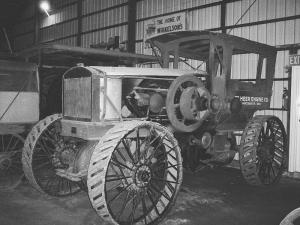2011 - Volume #35, Issue #5, Page #22
[ Sample Stories From This Issue | List of All Stories In This Issue | Print this story
| Read this issue]
Heer Tractor Was Ahead Of Its Time
 |
“It was brought to Stayton, Ore. to pull four large freight wagons of flour to Salem where they could be shipped by riverboat, rail or other means to markets,” says Jim Heater, Silver Mountain Christmas Trees, Inc. “It was geared to approach 5 mph while other tractors ran 1 to 2 mph.”
As roads improved, trucks replaced the Heer. Heater’s dad had seen it while still a boy in school in Stayton. In 1949 or 1950, he bought it, towed it 10 miles to his farm, serviced the engine and put it to use.
“We honestly don’t know how much it would pull,” recalls Heater. “We never hooked it to anything it couldn’t handle.”
The Heer has a marine-type, opposed, two-cylinder engine. It’s governed at 450 rpm’s and idles at 200 rpm’s. The 7/8-in. link, chain drive runs through the transmission assembly and around sprockets on front and rear differentials.
“The drive chain is the biggest I have ever seen. It’s similar to an anchor chain,” says Heater.
The Heer has a rigid frame with differential casing with flexible mounting to the frame on both front and rear axles. The front axle has a ball and socket mounting. The rear has a king bolt mount and flexible bracing.
Shifting disc-type clutches engage high and low gears in order. A separate disc clutch shifts from forward to reverse and back.
All-wheel steering is made possible by a steering shaft with two worm gears. Chains from the worm gears run to each axle. Wheels are 50 in. in diameter with a 12-in. wide, open tread. Even with the all-wheel steering, the tractor has a substantial turning radius. Starting it was also a substantial job.
“You don’t use a crank,” says Heater. “You use a 3 to 4-ft. long bar with a band and clamping unit on one end, like what’s used to loosen oil or fuel filters. It fits around a small pulley on the outside of the flywheel. After pulling the engine a few times, a knife switch turns on the battery-powered ignition. A few more turns and it starts up.”
After a few years, Heater’s dad sold the Heer tractor. Fast forward to the early 1990’s, and Heater was asked to pick up and move a tractor to the Antique Powerland museum.
“It was the same serial number as the one my dad had,” says Heater. “It’s now owned by two local men who have put it on display at the museum.”
Contact: FARM SHOW Followup, Antique Powerland , 3995 Brooklake Rd. N.E., Brooks, Ore. 97303 (ph 503 393-2424; apmaoffice@eschelon.com; www.antiquepowerland.com).

Click here to download page story appeared in.

Click here to read entire issue
To read the rest of this story, download this issue below or click here to register with your account number.




